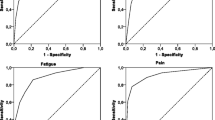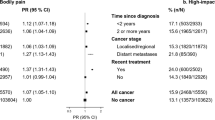Abstract
Purpose
To explore (1) the information obtained from related but conceptually different approaches to pain assessment and (2) the extent to which the European Organisation for Research and Treatment of Cancer Quality of Life Questionnaire-Core 30 (EORTC QLQ-C30) can be used as a screening tool to predict patient-reported need for pain relief.
Methods
Cancer patients randomly sampled from 56 hospital departments were included. Questionnaire items assessed patients’ (a) pain experience using the EORTC QLQ-C30 pain scale and its two pain items separately (pain intensity and pain interference) and (b) pain burden and (c) need for pain relief using the Three-Levels-of-Needs Questionnaire (3LNQ).
Results
Of the 2364 patients contacted by mail, 1447 (61 %) completed the questionnaires. Among these, 51 % reported at least “a little” pain on the pain intensity item. The number of patients reporting pain to be a burden was similar, and pain experience and pain burden were highly correlated (correlation coefficients ranged from 0.85 to 0.91). Pain experience and pain burden were moderately correlated with the need for pain relief. A receiver-operating characteristic (ROC) curve analysis showed that the EORTC QLQ-C30 discriminated between patients with and without a need for pain relief to an acceptable degree (area under the curve (AUC) 0.73–0.77). The cut-point a little gave a sensitivity of 84 % and specificity of 59 % for the item “Have you had pain?” and a sensitivity of 72 % and a specificity of 72 % for the pain scale.
Conclusions
The majority of patients who experienced pain felt it to be a problem. Pain experience and pain burden were substantially related to need for pain relief, and the latter could be predicted from the EORTC QLQ-C30.

Similar content being viewed by others
References
Koffman J, Morgan M, Edmonds P, Speck P, Higginson I (2008) Cultural meanings of pain: a qualitative study of Black Caribbean and White British patients with advanced cancer. Palliat Med 22:350–359
Larsson A, Wijk H (2007) Patient experiences of pain and pain management at the end of life: a pilot study. Pain Manag Nurs 8:12–16
Hui D, Bruera E (2014) A personalized approach to assessing and managing pain in patients with cancer. J Clin Oncol 32:1640–1646
van den Beuken-van Everdingen MH, de Rijke JM, Kessels AG, Schouten HC, van Kleef M, Patijn J (2007) High prevalence of pain in patients with cancer in a large population-based study in the Netherlands. Pain 132:312–320
Meuser T, Pietruck C, Radbruch L, Stute P, Lehmann KA, Grond S (2001) Symptoms during cancer pain treatment following WHO-guidelines: a longitudinal follow-up study of symptom prevalence, severity and etiology. Pain 93:247–257
Deandrea S, Montanari M, Moja L, Apolone G (2008) Prevalence of undertreatment in cancer pain. A review of published literature. Ann Oncol 19:1985–1991
Jacobsen R, Samsanaviciene J, Liubarskiene Z, Sjøgren P, Møldrup C, Christrup L, Sciupokas A, Hansen OB (2014) Barriers to cancer pain management in Danish and Lithuanian patients treated in pain and palliative care units. Pain Manag Nurs 15:51–58
Gunnarsdottir S, Donovan HS, Serlin RC, Voge C, Ward S (2002) Patient-related barriers to pain management: the Barriers Questionnaire II (BQ-II). Pain 99:385–396
Reid CM, Gooberman-Hill R, Hanks GW (2008) Opioid analgesics for cancer pain: symptom control for the living or comfort for the dying? A qualitative study to investigate the factors influencing the decision to accept morphine for pain caused by cancer. Ann Oncol 19:44–48
Stromgren AS, Groenvold M, Sorensen A, Andersen L (2001) Symptom recognition in advanced cancer. A comparison of nursing records against patient self-rating. Acta Anaesthesiol Scand 45:1080–1085
Detmar SB, Muller MJ, Schornagel JH, Wever LD, Aaronson NK (2002) Health-related quality-of-life assessments and patient-physician communication: a randomized controlled trial. JAMA 288:3027–3034
Marshall S, Haywood K, Fitzpatrick R (2006) Impact of patient-reported outcome measures on routine practice: a structured review. J Eval Clin Pract 12:559–568
Berry DL, Blumenstein BA, Halpenny B, Wolpin S, Fann JR, Austin-Seymour M, Bush N, Karras BT, Lober WB, McCorkle R (2011) Enhancing patient-provider communication with the electronic self-report assessment for cancer: a randomized trial. J Clin Oncol 29:1029–1035
Santana MJ, Feeny D (2014) Framework to assess the effects of using patient-reported outcome measures in chronic care management. Qual Life Res 23:1505–1513
Velikova G, Booth L, Smith AB, Brown PM, Lynch P, Brown JM, Selby PJ (2004) Measuring quality of life in routine oncology practice improves communication and patient well-being: a randomized controlled trial. J Clin Oncol 22:714–724
Snyder CF, Garrett-Mayer E, Blackford AL, Brahmer JR, Carducci MA, Pili R, Stearns V, Wolff AC, Dy SM, Wu AW (2009) Concordance of cancer patients’ function, symptoms, and supportive care needs. Qual Life Res 18:991–998
Snyder CF, Blackford AL, Okuyama T, Akechi T, Yamashita H, Toyama T, Carducci MA, Wu AW (2013) Using the EORTC-QLQ-C30 in clinical practice for patient management: identifying scores requiring a clinician’s attention. Qual Life Res 22:2685–2691
Kuijpers W, Giesinger JM, Zabernigg A, Young T, Friend E et al (2015) Patients’ and health professionals’ understanding of and preferences for graphical presentation styles for individual-level EORTC QLQ-C30 scores. Qual Life Res
Aaronson NK, Ahmedzai S, Bergman B, Bullinger M, Cull A, Duez NJ et al (1993) The European organization for research and treatment of cancer QLQ-C30: a quality-of-life instrument for use in international clinical trials in oncology. J Natl Cancer Inst 85:365–376
Petersen MA, Aaronson NK, Chie WC, Conroy T, Costantini A, Hammerlid E, Hjermstad MJ, Kaasa S, Loge JH, Velikova G, Young T, Groenvold M (2016) Development of an item bank for computerized adaptive test (CAT) measurement of pain. Qual Life Res 25(1):1–11
Snyder CF, Blackford AL, Brahmer JR, Carducci MA, Pili R, Stearns V, Wolff AC, Dy SM, Wu AW (2010) Needs assessments can identify scores on HRQOL questionnaires that represent problems for patients: an illustration with the Supportive Care Needs Survey and the QLQ-C30. Qual Life Res 19:837–845
Seow H, Sussman J, Martelli-Reid L, Pond G, Bainbridge D (2012) Do high symptom scores trigger clinical actions? An audit after implementing electronic symptom screening. J Oncol Pract 8:e142–e148
Johnsen AT, Petersen MA, Pedersen L, Groenvold M (2011) Development and initial validation of the Three-Levels-of-Needs Questionnaire for self-assessment of palliative needs in patients with cancer. J Pain Symptom Manage 41:1025–1039
Johnsen AT, Tholstrup D, Petersen MA, Pedersen L, Groenvold M (2009) Health related quality of life in a nationally representative sample of haematological patients. Eur J Haematol 83:139–148
Johnsen AT, Petersen MA, Pedersen L, Groenvold M (2009) Symptoms and problems in a nationally representative sample of advanced cancer patients. Palliat Med 23:491–501
American Joint Committee on Cancer (2002) AJCC—cancer staging manual. Springer, Chicago
Fayers, Aaronson, Bjordal, Groenvold, Curran et al (2001) EORTC QLQ-C30 scoring manual. Sixth edition. European Organization for Research and Treatment of Cancer, Brussels
SAS Institute Inc (2011) SAS/STAT 9.3 user’s guide. SAS Institute Inc, Cary
Looney SW, Hagan JL (2015) Analysis of biomarker data: a practical guide. John Wiley and Sons Inc., New Jersey
Portenoy RK, Thaler HT, Kornblith AB, Lepore JM, Friedlander-Klar H, Kiyasu E, Sobel K, Coyle N, Kemeny N, Norton L et al (1994) The Memorial Symptom Assessment Scale: an instrument for the evaluation of symptom prevalence, characteristics and distress. Eur J Cancer 30A:1326–1336
Acknowledgments
We wish to thank the patients participating in the study. The study was supported by the Danish Cancer Society (PP01006, PP05033, and PP07031) and the Ministry of Health’s Grant for Development and Analysis (2003-0201-39).
Author information
Authors and Affiliations
Corresponding author
Ethics declarations
The authors declare that they have no conflict of interest. The funding source did not have any involvement in study design, data collection, analysis and interpretation, or in the dissemination of results.
All procedures performed in the study were in accordance with the ethical standards of the institutional and/or national research committee and with the 1964 Helsinki declaration and its later amendments or comparable ethical standards. Informed consent was obtained from all individual participants included in the study.
Conflict of interest
There are no conflicts of interest for any of the authors.
Electronic supplementary material
Below is the link to the electronic supplementary material.
Supplementary Fig. 1
(DOCX 15 kb)
Supplementary Fig. 2
(DOCX 29 kb)
Supplementary Fig. 3
(DOCX 29 kb)
Supplementary Fig. 4
(DOCX 29 kb)
Rights and permissions
About this article
Cite this article
Johnsen, A.T., Petersen, M.A., Snyder, C.F. et al. How does pain experience relate to the need for pain relief? A secondary exploratory analysis in a large sample of cancer patients. Support Care Cancer 24, 4187–4195 (2016). https://doi.org/10.1007/s00520-016-3246-7
Received:
Accepted:
Published:
Issue Date:
DOI: https://doi.org/10.1007/s00520-016-3246-7




